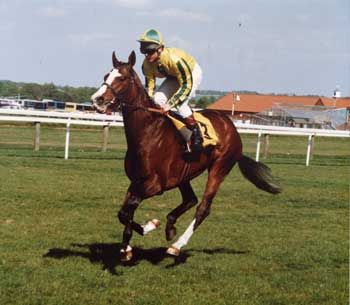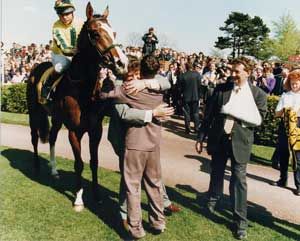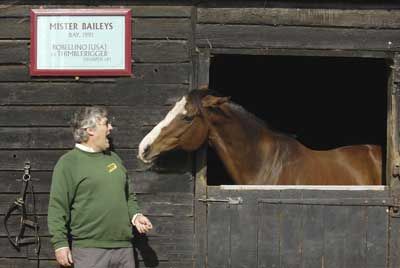8th
Oct
2009
Oct
2009
Mister Baileys 1991 - 2009
Paul Venner, Managing Direct or at Baileys, spotted the Robellino colt at the sales. “He was a lovely looking colt with his striking white blaze and a great stride,” said Paul Venner, “and he just spoke to me.” So, 10,500 guineas later, Baileys Horse Feeds was the owner.
or at Baileys, spotted the Robellino colt at the sales. “He was a lovely looking colt with his striking white blaze and a great stride,” said Paul Venner, “and he just spoke to me.” So, 10,500 guineas later, Baileys Horse Feeds was the owner.
He was not the first horse that Baileys had bought to race as they had been in the racing game more or less since Mark Johnston set up his first training yard in north Lincolnshire and Baileys were producing their first coarse mix for the performance horse. Mark Johnston was feeding Baileys exclusively to his horses and was a great help with the development of the racing feeds.
Mister Baileys had a successful 2-year-old campaign with three wins including the Lanson Champagne Vintage Stakes and Royal Lodge Stakes. The Madagans 2000 Guineas, in 1994, was his first outing as a 3-year-old and although he had every chance of a good performance, sights were more firmly set, at that time, on the Derby. In the end, however, the Guineas was to be his greatest occasion, with Mister Baileys wining in the fastest time ever recorded over the Rowley Mile, 1 minute 35.08 seconds, beating Zafonic’s record of the previous year. This was the first Classic win for trainer, Mark Johnston and jockey, Jason Weaver, and, of course, the first Classic for owners, Baileys Horse Feeds; a British win through and through and a truly great day.
Although Mister Baileys had won over a mile, his pedigree passed down from Roberto to Robellino suggested he would stay for the extra half mile to go the Derby distance, so after a disappointing third in the Dante at York, Epsom was his next race. Mister Baileys, with Jason Weaver on top, went out strongly and led from the front. He was well clear of the field but his stamina gave out and despite a brave effort he faded and was beaten into fourth. “The company shut down for the day, hired two buses and everyone went along. It was the most fantastic day,” recounts Paul Venner. “To see him coming round Tattenham Corner ahead of the field was one of the most exciting moments of my life. The fact that he didn’t quite make the distance and came home fourth was no shame. We were all so proud of him. We ran him again over a mile in the Sussex Stakes at Goodwood but, on reflection, I think we should have retired him after the Derby.”

A half share was bought by The National Stud in July 1994 but, before he could begin his stud career, he was struck down with grass sickness in the December. There are still huge gaps in our understanding of this debilitating disease, except that it is usually fatal, and the subsequent loss of Dubai Millennium some years later, highlighted the dangers once again. Mister Baileys did survive but it took him a while to build up strength and condition and, in October 1995, he was flown to Kentucky to stand at the Vinery Stud. Whilst he was there Paul Venner, who still retained a share in the horse, re-mortgaged his house to buy three mares to put to the stallion. One of those was Southern Psychic and her covering with Mister Baileys produced Rumpold who, in the ownership of Sheikh Mohammed Bin Maktoum Al Maktoum, enjoyed extensive success on the turf and all-weather .
Paul Venner still operates his successful Thoroughbred stud and, upholding enormous respect for Mister Baileys, supported him throughout his career. From the original 10,500 guineas, Mister Baileys provided an excellent return on his investment. The half share sale to The National Stud meant that Baileys Horse Feeds could expand their plant to keep up with the increasing demand for their products, particularly since Mister Baileys had increased the company name and profile in the racing industry. “Mister Baileys did great things for the Company,” says Paul, “and we will always owe him a huge debt of gratitude.”
Mister Baileys returned to the UK in 2000 and stood at Whitsbury Manor Stud where, with careful management, he continued to successfully cover mares until 2003 when he eventually became infertile. It was always the intention that he should retire to Paul Venner’s Petches Farm Stud and, after being gelded at the age of 12, this he did, much to the delight of all who’d known him there as a yearling and throughout his career. The long term effects of his earlier grass sickness continued to dog him however, and any plans for a new career under saddle were shelved when it became evident that it was likely he had just 33% of his gut function and 40% of liver function.
He continued to hack out during the summer though, accompanying yearlings and other youngsters on their first forays round the local lanes, and remained a two-year-old at heart until his dying day. “He didn’t like the idea of being turned away,” recalls Paul, “so we kept him in routine he was always convinced that any visitors to the farm were there to see him! I shall miss my late-night chats with him, when I used to take him an evening feed and shall always feel privileged to have been associated with such a fighter.” To help with continued research into the causes and possible cures for grass sickness, Mister Baileys’ body will be examined by scientists from Edinburgh and The Animal Health Trust.

Mister Baileys was obviously the best known of the Baileys racehorses but he was by no means the only one. Since 1986, when Good Buy Baileys was the first one to race (and win) under G R Bailey Ltd ownership, there have been nearly 50 others, including a handful of National Hunt horses. Recent contenders include Bahama Baileys, Baileys Vision and Baileys Red, flying the flag, searching for that next champion!
Baileys has many years experience feeding racehorses and enjoys an excellent relationship with many top trainers, in particular, Mark Johnston, who was such a great influence on the original formulations of the racing products. Breeding and producing Thoroughbreds and having horses in training as a company, is part of the business of manufacturing horse feeds as far as Baileys are concerned. What better way to prove that the products work! This is because they are not just formulated according to a computer programme that says they will do the job, but because the people that are in the business of feeding these horses say they work.
 or at Baileys, spotted the Robellino colt at the sales. “He was a lovely looking colt with his striking white blaze and a great stride,” said Paul Venner, “and he just spoke to me.” So, 10,500 guineas later, Baileys Horse Feeds was the owner.
or at Baileys, spotted the Robellino colt at the sales. “He was a lovely looking colt with his striking white blaze and a great stride,” said Paul Venner, “and he just spoke to me.” So, 10,500 guineas later, Baileys Horse Feeds was the owner. He was not the first horse that Baileys had bought to race as they had been in the racing game more or less since Mark Johnston set up his first training yard in north Lincolnshire and Baileys were producing their first coarse mix for the performance horse. Mark Johnston was feeding Baileys exclusively to his horses and was a great help with the development of the racing feeds.
Mister Baileys had a successful 2-year-old campaign with three wins including the Lanson Champagne Vintage Stakes and Royal Lodge Stakes. The Madagans 2000 Guineas, in 1994, was his first outing as a 3-year-old and although he had every chance of a good performance, sights were more firmly set, at that time, on the Derby. In the end, however, the Guineas was to be his greatest occasion, with Mister Baileys wining in the fastest time ever recorded over the Rowley Mile, 1 minute 35.08 seconds, beating Zafonic’s record of the previous year. This was the first Classic win for trainer, Mark Johnston and jockey, Jason Weaver, and, of course, the first Classic for owners, Baileys Horse Feeds; a British win through and through and a truly great day.
Although Mister Baileys had won over a mile, his pedigree passed down from Roberto to Robellino suggested he would stay for the extra half mile to go the Derby distance, so after a disappointing third in the Dante at York, Epsom was his next race. Mister Baileys, with Jason Weaver on top, went out strongly and led from the front. He was well clear of the field but his stamina gave out and despite a brave effort he faded and was beaten into fourth. “The company shut down for the day, hired two buses and everyone went along. It was the most fantastic day,” recounts Paul Venner. “To see him coming round Tattenham Corner ahead of the field was one of the most exciting moments of my life. The fact that he didn’t quite make the distance and came home fourth was no shame. We were all so proud of him. We ran him again over a mile in the Sussex Stakes at Goodwood but, on reflection, I think we should have retired him after the Derby.”

A half share was bought by The National Stud in July 1994 but, before he could begin his stud career, he was struck down with grass sickness in the December. There are still huge gaps in our understanding of this debilitating disease, except that it is usually fatal, and the subsequent loss of Dubai Millennium some years later, highlighted the dangers once again. Mister Baileys did survive but it took him a while to build up strength and condition and, in October 1995, he was flown to Kentucky to stand at the Vinery Stud. Whilst he was there Paul Venner, who still retained a share in the horse, re-mortgaged his house to buy three mares to put to the stallion. One of those was Southern Psychic and her covering with Mister Baileys produced Rumpold who, in the ownership of Sheikh Mohammed Bin Maktoum Al Maktoum, enjoyed extensive success on the turf and all-weather .
Paul Venner still operates his successful Thoroughbred stud and, upholding enormous respect for Mister Baileys, supported him throughout his career. From the original 10,500 guineas, Mister Baileys provided an excellent return on his investment. The half share sale to The National Stud meant that Baileys Horse Feeds could expand their plant to keep up with the increasing demand for their products, particularly since Mister Baileys had increased the company name and profile in the racing industry. “Mister Baileys did great things for the Company,” says Paul, “and we will always owe him a huge debt of gratitude.”
Mister Baileys returned to the UK in 2000 and stood at Whitsbury Manor Stud where, with careful management, he continued to successfully cover mares until 2003 when he eventually became infertile. It was always the intention that he should retire to Paul Venner’s Petches Farm Stud and, after being gelded at the age of 12, this he did, much to the delight of all who’d known him there as a yearling and throughout his career. The long term effects of his earlier grass sickness continued to dog him however, and any plans for a new career under saddle were shelved when it became evident that it was likely he had just 33% of his gut function and 40% of liver function.
He continued to hack out during the summer though, accompanying yearlings and other youngsters on their first forays round the local lanes, and remained a two-year-old at heart until his dying day. “He didn’t like the idea of being turned away,” recalls Paul, “so we kept him in routine he was always convinced that any visitors to the farm were there to see him! I shall miss my late-night chats with him, when I used to take him an evening feed and shall always feel privileged to have been associated with such a fighter.” To help with continued research into the causes and possible cures for grass sickness, Mister Baileys’ body will be examined by scientists from Edinburgh and The Animal Health Trust.

Mister Baileys was obviously the best known of the Baileys racehorses but he was by no means the only one. Since 1986, when Good Buy Baileys was the first one to race (and win) under G R Bailey Ltd ownership, there have been nearly 50 others, including a handful of National Hunt horses. Recent contenders include Bahama Baileys, Baileys Vision and Baileys Red, flying the flag, searching for that next champion!
Baileys has many years experience feeding racehorses and enjoys an excellent relationship with many top trainers, in particular, Mark Johnston, who was such a great influence on the original formulations of the racing products. Breeding and producing Thoroughbreds and having horses in training as a company, is part of the business of manufacturing horse feeds as far as Baileys are concerned. What better way to prove that the products work! This is because they are not just formulated according to a computer programme that says they will do the job, but because the people that are in the business of feeding these horses say they work.
Recent Articles


